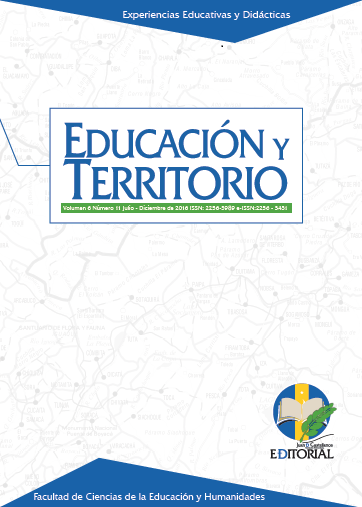Keywords:
teaching english, information and communication technologies (ICT), multimodal text, motivation, language learning.Abstract
Teachers who teach English as a foreign language use various tools in their lessons in order to motivate their students; among them we can mention the use of videos, songs, video games, among others, that conjugate or interrelate the verbal with the nonverbal code to consolidate meanings and representations; therefore, these didactic materials are constituted as multimodal texts. This is why the present article reflects on the importance of incorporating these new formats of texts in the teaching of English as a foreign language. It is expected that this work will contribute to understand that greater use should be made of audiovisual media, and not only privilege the use of the language code, as long as it is clear how to use them to ensure a meaningful teaching-learning process.
Downloads
References
Barragán, R., & Gómez, W. (2012). El lenguaje de la imagen y el desarrollo de la actitud crítica en el aula: propuesta didáctica para la lectura de signos visuales. Íkala, 17(1), 81-94. Medellín: Universidad de Antioquia.
Bastidas, J. (2002). How to use songs in the EFL/ESL class. Teoría y práctica de la Enseñanza de Inglés (pp. 65-78). Tunja: La estación.
Brown, S. (2006). Teaching listening. Cambridge: Cambridge University Press.
Castañeda, R. (2014). English teaching through project based learning method, in rural area. Cuadernos de Lingüística Hispánica, (23), 151-170. doi: https://doi.org/10.19053/0121053X.2344
Castillo, R. (2014). Teaching and learning another language strategically. Bogotá: Javegraf.
Farías, M., Obilinovic, K., & Orrego, R. (2013). El principio y efecto de redundancia en la retención y transferencia de expresiones idiomáticas en inglés como lengua extranjera. Íkala, revista de lenguaje y cultura, 18(1), 9-17. Medellín: Universidad de Antioquia.
Ferlazzo, L. (2012). Eight Ways to Use Video with English-Language Learners. Recuperado de http://www.edutopia.org/blog/ell-engagement-using-video-larry-ferlazzo-katie-hull-sypnieski
Figueroa, C., & Londoño Ramos, C. (2014). La escuela normal superior y los test en Colombia. Praxis & Saber, 5(10), 245-265. doi: https://doi.org/10.19053/22160159.3031
Fúquen Martínez, A., & Jiménez Niño, P. (2013). Implementing tasks that stimulate critical thinking in EFL classrooms. Cuadernos de Lingüística Hispánica, (21), 143-158. doi: https://doi.org/10.19053/0121053X.1955
García González, S., & Furman, M. (2014). Categorización de preguntas formuladas antes y después de la enseñanza por indagación. Praxis & Saber, 5(10), 75-91. doi: https://doi.org/10.19053/22160159.3023
García León, D. (2014). Minorías lingüísticas en Colombia. Acercamiento desde las políticas públicas y los derechos humanos. Cuadernos de Lingüística Hispánica, (24), 163-182. doi: https://doi.org/10.19053/0121053X.2765
García León, J. (2013). Identidad y actitudes lingüísticas en hablantes trilingües: inglés criollo, inglés estándar y español. Propuesta de investigación. Cuadernos de Lingüística Hispánica, (20), 25-40. Recuperado de http://revistas.uptc.edu.co/revistas/index.php/linguistica_hispanica/article/view/469
Gardner, R. C. (1985). Social psychology and second language learning: The role of attitudes and motivation. London: Edward Arnold.
Harmer, J. (2007). How to teach English. England: Pearson Education Limited.
Jiménez, L. (2015). Estudio de Caso de la Influencia de la Motivación Escolar en el Aprendizaje. Educación y Territorio, 4(1), 10-29. Recuperado de http://www.revistasjdc.com/main/index.php/reyte/article/view/325/316
Kress, G., & van Leeuwen, T. (2001). Multimodal discourse. The modes and media of contemporary communication. Londres: Arnold. Introducción, pp. 1-23.
Mayer, R., & Moreno, R. (2002). Aids to computer-based multimedia learning. Learning and instruction, 12, 107-119.
Pardo, N. (2014). Mediatización, multimodalidad y significado. Recuperado de http://www.redladcolombia.com/pdfs/Publicaciones/Mediatizacion%20multimodalidad%20y%20significado.pdf
Pró, M. (2003). Aprender con imágenes: Incidencia y uso de la imagen en las estrategias de aprendizaje. Barcelona: Paidós.
Ramos Holguín, B., & Aguirre Morales, J. (2014). Materials development in Use of multimodal tools in teaching english as a foreign language the Colombian context: Some considerations about its benefits and challenges. HOW, A Colombian Journal for Teachers of English, 21(2), 134-150.
Reina, E. (2010). The use of songs as a tool to work on listening and culture in EFL classes. Cuadernos de Lingüística Hispánica, 15, 121-138. Tunja: Uptc.
Samacá Bohórquez, I. (2015). La Práctica Pedagógica como lugar de Legitimación del Saber. Educación y Territorio, 5(8), 71-86. Recuperado de http://www.revistasjdc.com/main/index.php/reyte/article/view/469/484
Schnotz, W. (2002). Aprendizaje multimedia desde una perspectiva cognitiva. Boletín red estatal de docencia universitaria, 2(2), 1-12. Recuperado de http://www.uc3m.es/uc3m/revista/MAYO02/redu_boletin_vol2_n2.htm
Sevik, M. (2012). Teaching Listening Skills to Young Learners through “Listen and Do” Songs. English Teaching Forum, 50(3), 10-17. Washington: United States Department of State.
Silva Ortiz, S. (2012). Sentido de la práctica sistematizadora en la educación superior. Praxis & Saber, 3(5), 127-141. doi: https://doi.org/10.19053/22160159.1137
Toledo Castellanos, R. (2012). Las investigaciones artísticas, investigaciones de contexto. Praxis & Saber, 3(6), 43-88. doi: https://doi.org/10.19053/22160159.2003
Williamson, R., & Resnick, A. (2003). Re-presentando el poder: una lectura multimodal de algunos medios electrónicos. Versión. Estudios de comunicación y política, 13, 83-119. México: Universidad Autónoma Metropolitana.
Yassaei, S. (2012). Using Original Video and Sound Effects to Teach English. English Teaching Forum, 50(1), 12-16. Washington: United States Department of State.





